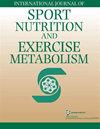Methodological Considerations for Investigating Iron Status and Regulation in Exercise and Sport Science Studies.
IF 3
3区 医学
Q2 NUTRITION & DIETETICS
International journal of sport nutrition and exercise metabolism
Pub Date : 2022-04-01
DOI:10.1123/ijsnem.2021-0343
引用次数: 4
Abstract
Iron deficiency is a common health issue in active and athlete populations. Accordingly, research into iron status, regulation, absorption, and iron deficiency treatment strategies is increasing at a rapid rate. However, despite the increase in the quantity of research, various methodological issues need to be addressed as we progress our knowledge in this area. The purpose of this review is to highlight specific considerations for conducting iron-related research in active and athlete populations. First, we discuss the methodological importance of assessment and interpretation of iron status, with reference to blood collection protocols, participant screening procedures, and biomarker selection. Next, we consider numerous variables that should be accounted for in the design of iron-related research studies, such as the iron regulatory hormone hepcidin and its interaction with exercise, in addition to an examination of female physiology and its impact on iron metabolism. Subsequently, we explore dietary iron and nutrient interactions that impact iron regulation and absorption, with recommendations made for optimal methodological control. Consideration is then given to key features of long-term study designs, such as the monitoring of training load, oral iron supplementation, dietary analysis, and general lifestyle factors. Finally, we conclude our recommendations with an exploration of stable iron isotope tracers as a methodology to measure iron absorption. Ultimately, it is our intention that this review can be used as a guide to improve study design, biomarker analysis, and reporting of findings, to maximize the quality of future research outputs in iron-related research focused on active and athlete populations.在运动和运动科学研究中研究铁的状态和调节的方法学考虑。
缺铁是活跃人群和运动员中常见的健康问题。因此,对铁的状态、调节、吸收和铁缺乏治疗策略的研究正在迅速增加。然而,尽管研究数量有所增加,但随着我们在这一领域的知识的进步,各种方法问题需要得到解决。这篇综述的目的是强调在运动人群和运动员人群中进行铁相关研究的具体考虑。首先,我们讨论了评估和解释铁状态的方法学重要性,参考了血液采集协议、参与者筛选程序和生物标志物选择。接下来,我们考虑了铁相关研究设计中应该考虑的许多变量,如铁调节激素hepcidin及其与运动的相互作用,以及对女性生理学及其对铁代谢的影响的研究。随后,我们探讨了影响铁调节和吸收的膳食铁和营养相互作用,并提出了最佳方法控制的建议。然后考虑长期研究设计的关键特征,如训练负荷监测、口服补铁、饮食分析和一般生活方式因素。最后,我们总结了我们的建议,探索稳定的铁同位素示踪剂作为测量铁吸收的方法。最终,我们希望这篇综述可以作为改进研究设计、生物标志物分析和结果报告的指南,以最大限度地提高未来以运动人群和运动员为重点的铁相关研究的质量。
本文章由计算机程序翻译,如有差异,请以英文原文为准。
求助全文
约1分钟内获得全文
求助全文
来源期刊
CiteScore
5.00
自引率
8.00%
发文量
50
审稿时长
6-12 weeks
期刊介绍:
The International Journal of Sport Nutrition and Exercise Metabolism (IJSNEM) publishes original scientific investigations and scholarly reviews offering new insights into sport nutrition and exercise metabolism, as well as articles focusing on the application of the principles of biochemistry, physiology, and nutrition to sport and exercise. The journal also offers editorials, digests of related articles from other fields, research notes, and reviews of books, videos, and other media releases.
To subscribe to either the print or e-version of IJSNEM, press the Subscribe or Renew button at the top of your screen.

 求助内容:
求助内容: 应助结果提醒方式:
应助结果提醒方式:


